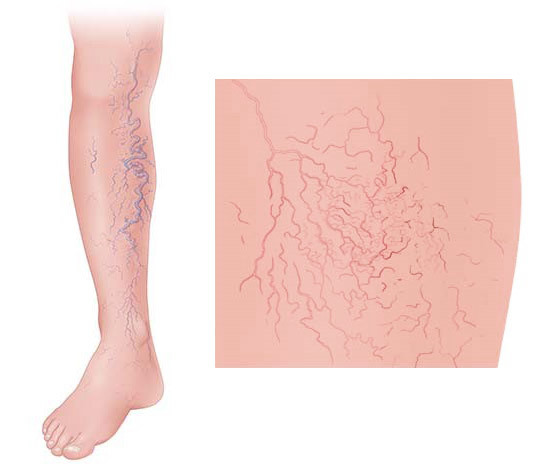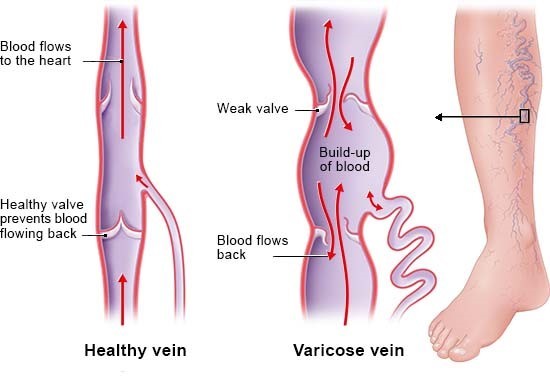NCBI Bookshelf. A service of the National Library of Medicine, National Institutes of Health.
InformedHealth.org [Internet]. Cologne, Germany: Institute for Quality and Efficiency in Health Care (IQWiG); 2006-.
Introduction
Varicose veins are mostly a cosmetic issue for many people. But these blueish veins right under the surface of the skin can also cause problems like heavy legs or cramps in the lower legs (calves).
Varicose veins are most commonly found on the calves or on the inner leg. They develop when blood builds up in the superficial veins of the legs. These veins then typically become swollen, raised and appear purple or blue through the skin.
A milder form of varicose veins is known as spider veins. These are thinner reddish or bluish veins under the surface of the skin. They often affect the legs, and are sometimes found on the face. Spider veins are common, but harmless.

Left: Varicose veins, Right: Spider veins
Symptoms
Varicose veins may cause the legs to feel heavy and swell up, especially around the ankles. The skin may also feel tight or itch. The symptoms usually get worse towards the end of the day – especially after sitting or standing for long periods of time. Varicose veins sometimes cause pain or cramps in the calf muscles at night too. Warm weather often makes the symptoms worse.
The appearance of the varicose veins doesn't always indicate how severe the symptoms are: For example, varicose veins that don't look bad might actually cause a great deal of discomfort, while ones that are very large and bumpy may not cause any noticeable symptoms.
Varicose veins can affect your wellbeing too. Some people are so bothered by what the veins look like that they don't want to show their legs in public. They stop wearing shorts and don't go to swimming pools, for example. Even if varicose veins aren't causing any other problems, if someone is very troubled by the appearance of their legs, it might be worth considering treatment.
Causes
Our legs have both deep and superficial veins.
- The deep leg veins carry oxygen-poor blood to the heart. Our leg muscles help to do this: When you walk, they squeeze the deep leg veins and push the blood upwards to the heart, like a pump.
- The superficial veins in the legs are found just under the skin and transport blood from the skin, fat tissue and muscles to the deep veins.
There are valves inside the veins that prevent the blood from flowing backwards.

Blood flowing backwards in varicose veins in the legs
Varicose veins can develop if the blood starts to build up in the superficial veins. The main cause of this is weak vein walls and valves. Another reason might be that not enough pressure is put on the veins – for example, if you stand too long and too often in one place without activating the leg muscles.
Risk factors
The factors that increase your risk of varicose veins include:
- Older age
- Genetic predisposition (your genes)
- Being very overweight
- Jobs where you have to stand for long periods of time
- Vascular (blood vessel) diseases such as deep vein thrombosis (DVT)
Women often first get varicose veins during pregnancy. This is probably due to a combination of two factors – hormone-related changes in their body's tissue and weight gain – which makes it harder for the blood in their leg veins to flow back to the heart properly. But these varicose veins often go away within several months of giving birth.
Prevalence
It is estimated that about 20% of all adults will get varicose veins at some point in their lives. Although they are more common in older people, young people sometimes have them too. Varicose veins are more common in women than in men.
Effects
Venous leg ulcers are the most common complication of varicose veins. If varicose veins aren't treated, they develop into open wounds about 3 to 6% of the time. Other possible complications such as vein inflammations, thrombosis or bleeding are rare.
The following problems may be signs of a complication and should be checked out by a doctor fast:
- Ulcers or open wounds in the ankle area that were not caused by an injury and have still not healed after two weeks
- Major swelling in the leg
- Reddened veins that feel warm and are painful
- Bleeding from or near varicose veins
- A rash near the varicose veins
Bleeding of varicose veins is rare but can be dangerous, so immediate medical attention is needed. As first-aid treatment, it's important to raise the leg and apply pressure to the site of bleeding.
Diagnosis
Varicose veins are easily recognizable by their typical appearance. A special kind of ultrasound called a duplex (or Doppler) ultrasound is used to gain information about the blood flow in the veins and leaks in the venous valves. It also helps to assess the veins before surgery.
Treatment
The following things are often recommended for the relief of varicose vein symptoms:
- Avoid standing or sitting for a long time
- Move as much as you can in everyday life
- Put up your legs when you sit
- Don't cross your legs when you sit
- Lose some weight if you are overweight
Compression stockings put pressure on the veins and are designed to support the flow of blood. But there's hardly any research on whether or how well they can help to reduce the symptoms of varicose veins. The same is true for weight loss.
There is also no proof of the effectiveness of creams, lotions, tablets or dietary supplements that are available for the treatment of vein problems. These products often contain horse chestnut or red vine leaf extracts.
If the symptoms of varicose veins are too severe or are very distressing because of their appearance, then a medical procedure may help. Varicose veins can be surgically removed, sealed using heat or destroyed using chemicals.
These are the most common surgical procedures:
- Vein stripping: Two incisions (cuts) are made on the leg and the entire vein is pulled out through an incision near the groin.
- Phlebectomy: Several small incisions (just a few millimeters wide) are made along the affected vein, which is then removed in several pieces. This technique is mainly used to treat smaller veins.
Nowadays, varicose veins are often sealed off using heat because that is associated with a lower risk of complications than surgery is. This can be done in two ways:
- Radiofrequency ablation: A thin tube (catheter) is inserted into the vein through a small cut (incision). Then a transducer is guided into the catheter. The transducer sends out electromagnetic waves (radio waves). These waves produce heat that is used to seal off the veins.
- Endovenous laser ablation: This treatment also involves heating the vein from the inside to close it off, but lasers are used instead of radio waves.
Another treatment option is known as sclerotherapy. This approach involves injecting a liquid or foam into the affected vein. The drug that it contains damages the vein so much that it is transformed into connective tissue , sealing off the vein. One possible side effect of this treatment is the skin turning a brownish color at the injection sites. That usually goes away within a few weeks or months.
In Germany, not every health insurer will cover all of these treatments, so it's a good idea to find out in advance about which of them are covered.
Further information
When people are ill or need medical advice, they usually go to see their family doctor first. Read about how to find the right doctor, how to prepare for the appointment and what to remember.
Sources
- Jones WS, Vemulapalli S, Parikh KS, Coeytaux RR, Crowley MJ, Raitz G et al. Treatment Strategies for Patients with Lower Extremity Chronic Venous Disease (LECVD). April 6, 2017. (AHRQ Technology Assessments). [PubMed: 30222278]
- National Institute for Health and Care Excellence (NICE). Varicose veins: diagnosis and management. July 24, 2013. (NICE Clinical guidelines; Volume 168).
- Nesbitt C, Bedenis R, Bhattacharya V, Stansby G. Endovenous ablation (radiofrequency and laser) and foam sclerotherapy versus open surgery for great saphenous vein varices. Cochrane Database Syst Rev 2014; (7): CD005624. [PubMed: 25075589]
- Paravastu SC, Horne M, Dodd PD. Endovenous ablation therapy (laser or radiofrequency) or foam sclerotherapy versus conventional surgical repair for short saphenous varicose veins. Cochrane Database Syst Rev 2016; (11): CD010878. [PMC free article: PMC6464398] [PubMed: 27898181]
- Robert Koch-Institut (RKI), Statistisches Bundesamt (Destatis). Venenerkrankungen der Beine (Gesundheitsberichterstattung des Bundes; Band 44). Berlin: RKI; 2009.
- Vemulapalli S, Parikh K, Coeytaux R, Hasselblad V, McBroom A, Johnston A et al. Systematic review and meta-analysis of endovascular and surgical revascularization for patients with chronic lower extremity venous insufficiency and varicose veins. Am Heart J 2018; 196: 131-143. [PubMed: 29421005]
IQWiG health information is written with the aim of helping people understand the advantages and disadvantages of the main treatment options and health care services.
Because IQWiG is a German institute, some of the information provided here is specific to the German health care system. The suitability of any of the described options in an individual case can be determined by talking to a doctor. We do not offer individual consultations.
Our information is based on the results of good-quality studies. It is written by a team of health care professionals, scientists and editors, and reviewed by external experts. You can find a detailed description of how our health information is produced and updated in our methods.
- Varicose veins: Overview - InformedHealth.orgVaricose veins: Overview - InformedHealth.org
Your browsing activity is empty.
Activity recording is turned off.
See more...
